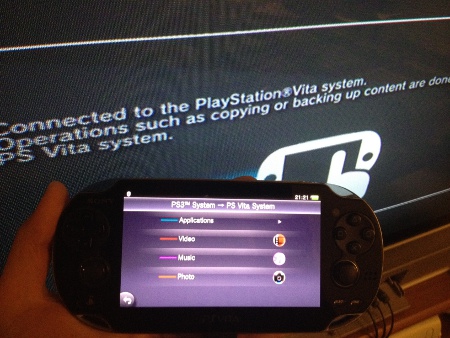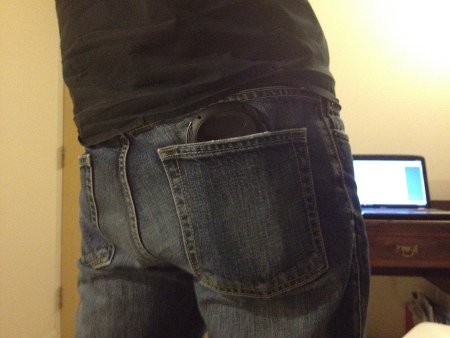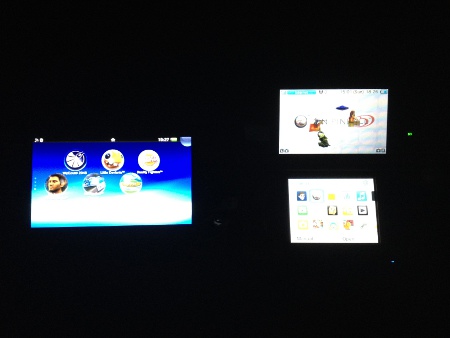We answer your PS Vita FAQ: rear touchscreen work well? Too expensive? Do you need one? Why did Sony bother?
And more

The very kind people at Sony sent us a couple of PS Vitas on January 9th, a full month and a half before they're launched across Europe.
So, we decided that before the system sees the light of day, you should have the chance to ask any question you like about the hardware. (If we couldn't answer it immediately, we'd, of course, go away and investigate it for you.)
To that end, we put the call out for PS Vita questions on our Twitter channel. Lo and behold, a number of you responded.
Some of your questions were of a technical nature, some were inviting opinions on the launch, and some were brilliantly baffling.
All of them were answered, though. Find out how by reading the following beautifully constructed paragraphs.
@joshuavanegmond - Why use it instead of a Sony phone & what does it offer over the PSP? I don't mean features, just stuff you would actually use.The Xperia Play is a mobile first and a gaming machine second. A narrow second, but second nonetheless. It's a communication device that will also let you play FIFA on it, whereas the Vita is designed from the ground up to let you play FIFA on it, as well as send some messages to friends over PlayStation Network.
If you want a phone-like experience, then the Vita is absolutely not for you. It's a bit too big, for starters.
Sure, there's Party chat (which allows you to converse in audio or text form with your friends), an internet browser for surfing on the go, and Near for location-based fun. But, let's be clear: the Vita is first and foremost a portable gaming machine.
 @huntervp - How easy is the transferring of data from PS3 or PC to the Vita?
@huntervp - How easy is the transferring of data from PS3 or PC to the Vita?
It's very simple, but a mite slow for both.
Via the PlayStation 3, it's a case of just plugging your Vita in using the included USB cable and then selecting which content you would like to transfer on the Vita's touchscreen.
If you're taking content from the PC, then you'll need to download the Content Manager Assistant application first. But, after that, it's exactly the same process.
There are drawbacks, though. Both the PS3 and PS Vita's other functionality is inaccessible during this entire process, though you can continue to use your PC as normal. So, if you're jonesing to play some Uncharted: Golden Abyss while you're sideloading Chemical Brothers's back catalogue, you're out of luck.
It will also only let you transfer one type of content from a source at any one time: you can't sideload games, video, and music all at the same time. This wouldn't be so much of an issue if the transfer rates weren't quite so slow - we are talking about a USB connection, after all.
Where this hits hardest is in transferring full games. The launch titles are all around 1GB or more and take a significant amount of time to be copied over, so if you have a wi-fi connection available to you, it'll be best to download digital content from the Store straight to the unit.
@SnakeSkinDesign - Does the rear touchscreen work well?Yes, surprisingly so. It's a very accurate input method, despite your not being able to see where your fingers are positioned on the device.
What's key, though, is how successfully developers have implemented it into their games. From the large selection of preview material we were sent, very few of them use it for tasks that require incredible precision. Instead, they focus on the ability to replicate a pinch when used in tandem with the front screen, or have you trace a simple line.
It adds a tactile twist to some of the software, and after a couple of hours of play with the unit, you become very aware of its shape, weight, and feel, because you're often asked to interact with it in such diverse methods.
So, it's a neat addition, and it'll be interesting to see how content creators use it moving forward.
 @stevetheblack - Does it still fit in your back pocket without violating you with its analogue sticks?
@stevetheblack - Does it still fit in your back pocket without violating you with its analogue sticks?
I'll answer this in two parts.
As you can see see from the photograph above, the answer is 'no' - the Vita doesn't really fit in a pocket. I pride myself on having very deep "change caverns", and even so it protruded out somewhat. It's a device to sling in your bag or, at the very least, your jacket's inside pocket.
Regarding the second point, I can confirm that violation levels were at a minimum. The sticks aren't flush with the main body of the unit itself, but they're not that far out either... maybe, half a centimetre at most. It's a little uncomfortable when wandering around with it for a while, but it's not awful.
Of course, you could just turn it the other way around and avoid the stick problem altogether. Pervert.
@EvanEscence40 - I have a question - why did they bother?Well, the PSP had a decent start in life, with some excellent content right out the gate. However, when the system was hacked to allow custom firmware to run on it - making piracy incredibly easy - companies tended to lose interest in developing new software.
Sales of the PSP are still darn good in Japan, though, and I firmly believe Sony feels like it can be a competitor in the market.
There's definitely space for a second dedicated handheld, too. Nintendo has always dominated in that area, but the success of PSP in Japan, combined with a lacklustre 3DS launch, has loosened Nintendo's tight grip on the potential audience.
With a steadily-growing economic climate and more interest than ever in both mobile devices and video games themselves, money is to be made and great games are to be played.
Oh, hold on... you were trolling. Right, gotcha, very good.
 @MarzyC3 - What's the Vita's screen brightness like compared to the 3DS's?
@MarzyC3 - What's the Vita's screen brightness like compared to the 3DS's?
Pictures can speak louder than words, and in the above instance, they probably do.
As you can see, there's not really a lot in it. Brightness is controlled using a slider under the 'settings' menu, so you can always adjust it to suit your needs. No complaints from my experience.
@halbpro - How effective is it as a rudimentary blackjack in a street fight?If you're getting into scraps on a regular basis and you'd like to use a games system as a makeshift bludgeon, then unfortunately I can't really recommend the Vita.
The Vita is well built, feels much more sturdy than the already solid PSP-2000, has a metallic finish to the edges, and produces none of those worrying creaks the PSPs had when you twisted their bodies accidentally.
That said, the screen is massive and therefore likely to break should you wield it in a fracas. I'd also say that dropping it would be a bad idea. In addition, the overall design is smooth and sleek, all rounded edges and contours, so any strike against an assailant would likely bounce off them.
I should reinforce that while it's not flimsy, it's just not a tank. And think of the baseball bat you could buy for £230.
@InformalMrTom - Why is it criminally expensive?@ReidFeed - Do you think it's worth the price tag, and do you think it's worth shelling out for a 32GB card?
I've combined these enquiries because they're essentially the same question. I think 'expensive' is a relative term. For a handheld, it's undoubtedly dear, though not as much as you may think.
If we look at prices historically, the Gizmondo was $400 at launch for the ad-free version, as was the Tapwave Zodiac. The NEC TurboExpress, meanwhile, was just above that by today's standards. Admittedly, these devices pretty much died a death at retail, but it puts a lot of the hyperbole about price spouted on forums into context.
The price of the baseline Vita unit is equal to that of the 3DS's at launch. However, Nintendo's portable console also includes a memory card for saving content, whereas the Vita doesn't. The wi-fi-only Vita is currently £230 (give or take), a 4GB card is another £15, and a game could be up to £40, so you're looking at shelling out just shy of £300 for everything you need to get started.
The cards are absolutely too expensive, and they'll likely remain that way for a bit. I'd suggest getting the 4GB card initially, and tiding yourself over until they fall in price. Be mindful, therefore, of downloading too many games from the Store at once. You may also not need a card to begin with, as some physical releases will include space for saves.
The main reason that the price is relative, though, is due to the technology you're getting. This is a home console on the go, and the system pushes high-quality visuals around effortlessly. It has more input methods than any other portable gaming system, superb audio, and well-integrated online services.
The games are already approaching home console quality, even at launch, so I don't even think these are any more overpriced than Xbox 360 or PS3 titles. What there aren't enough of at launch, mind, are bite-sized gaming experiences at an appropriate price, which is where Apple has Sony licked for the time being.
If sales in Japan are anything to go on, then we may see a price drop in 12 months - or perhaps a bit earlier - to make it a more attractive proposition and significantly cut into Nintendo's share of the handheld audience. This is all speculation, of course, and will depend entirely on how the console performs in the marketplace.
 @Benjo321 - Can you send silly picture messages like you can on the 3DS? And how bad is that f**king web browser?!
@Benjo321 - Can you send silly picture messages like you can on the 3DS? And how bad is that f**king web browser?!
Well, Mr Swearypants, I'm afraid drawing pictures and sending them to friends (on the latest-generation handhelds) will - for the time being - only be possible on the 3DS. It's a shame, really, because I think the Vita's touchscreen is accurate enough to handle a simple painting program, and the online infrastructure is definitely there.
The browser is robust, but you won't use it over your smartphone or tablet. Ever.
It doesn't support HTML5 or Flash, so sites like YouTube are out. Plus, there isn't an option to view a page in portrait mode, making for an unwieldy world wide web experience. It loads pages at a respectable rate, and there are bookmarking options, but you have a better browser in your pocket, so why bother?
@ShennyUK - Do I need one?Well, that's the biggest question of all, isn't it? Ultimately, it's all down to the quality of games, innit. We're currently not allowed to talk specifics about titles due to an embargo that lifts in February: however, we can say the following.
We have in our possession five titles from the launch line-up that we haven't yet reviewed - our write-up of the Japanese version of Uncharted: Golden Abyss is here - and I can confidently say that several of them are great, while one of them is outstanding. You know - a real system-seller.
The price is still a barrier, but if you've got the moolah to throw about, then it's a 'yes'. If you don't have a 3DS (or don't like Nintendo's approach to game design) but would like something to play games on that isn't a mobile, then again it's a 'yes'.
However, there are two demographics I would initially suggest should avoid buying a Vita.
Firstly, parents looking for something for their children: this is a complicated bit of kit, and though most titles would suit ages 13 and up, there's not a lot for younger hands and minds.
Secondly, anyone that is turned off by the flagship PlayStation series. Sony hasn't been slow in turning to a number of its own IPs to generate enthusiasm for Vita: your Uncharteds, WipEouts, LittleBigPlanets, and MotorStorms are all on the horizon / in full view already. If these don't appeal, then hold off for six months - wait and see what else they come up with and then re-evaluate.
For even more answers to FAQ on the PS Vita, check out this handy little feature.
